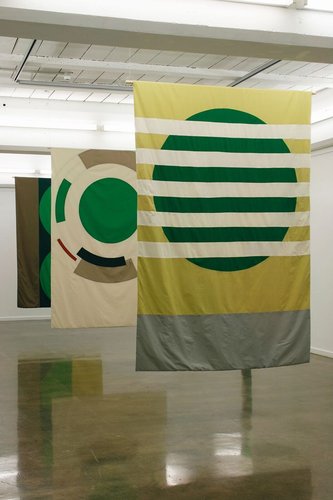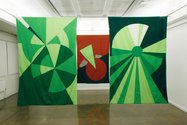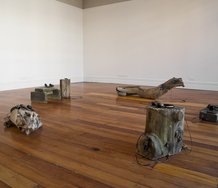Megan Dunn – 24 December, 2017
—for six of the eight farms that make up the Benmore Irrigation Company (BIC) in the Mackenzie Basin seeking to double their irrigable land area, irrigation circles probably seem quite constructive indeed, but not for New Zealand Forest and Bird who say, “we believe this will destroy this special landscape and push our endangered species closer to extinction,” while Lillico herself says, “the green irrigation circles that now inhabit these landscapes are central motifs in this exhibition, which refers to the history of geometric abstraction as a tool of political protest”—
I wasn’t going to review this show but I kept circling back to it - because if not me then who?—and it is a show worth a review because it works the way a circle works, so don’t redesign the wheel—eight double-sided fabric banners of circles—some broken others whole - are hung in a row down the centre of the L shaped Toi Poneke Gallery (inconveniently not laid out in a circle) each embroidered in fabrics of verdant green and bisected and dissected like pie graphs; Lillico’s circles seemed symbolic of something— vicious?—maybe, because it turns out that the design of each banner is based on Google Earth Images (those two OO’s in Google-blink-blink) of the Canterbury Plains (Kā pakihi whakatekateka a Waitaha) and the Mackenzie Basin (Te Manahuna) so each banner also traces the trajectory of a giant pivot irrigator or a central pivot irrigation also called a waterwheel or circle irrigation—am I making my point or am I being…irrigating?—and even though this show is now over Lillico’s vicious circles are still fanning out over the Canterbury plains—pitter patter—and the Mackenzie Basin—pitter patter—beads of water, falling, falling, irrigating, irrigating—and one day Kirsty flying overhead from Wellington to Dunedin was struck by their modernist design, like constructivism, but how constructive are irrigation circles?—for six of the eight farms that make up the Benmore Irrigation Company (BIC) in the Mackenzie Basin seeking to double their irrigable land area, irrigation circles probably seem quite constructive indeed, but not for New Zealand Forest and Bird who say, “we believe this will destroy this special landscape and push our endangered species closer to extinction,” while Lillico herself says, “the green irrigation circles that now inhabit these landscapes are central motifs in this exhibition, which refers to the history of geometric abstraction as a tool of political protest”—and my mind is still spinning because I don’t know much about the history of geometric abstraction as a tool of political protest—for instance I didn’t know that the last banner in Lillico’s show, the one at the very end of the L, which depicts a green cake slice intersecting a bright brown banner was a reference to El Lissitzky’s Soviet propaganda poster Beat the Whites with the Red Wedge (1919-20) in which the red wedge symbolises the Bolsheviks defeating their opponents, the White movement, during the Russian Civil War—but what about Lillico’s green wedge? What does it symbolise? The farmers defeating Grahame Sydney’s “Big Sky” country? The Forest and Bird website includes a prominent Sydney quote, “I believe that landscapes have a power and a meaning far beyond any temporary economics. Landscapes, the natural theatres of our personal experiences and dramas, perform a symbolic and emotional function miles beyond their economic or geographical rationale” and is that what Lillico’s Vicious Circles are really about? How effective is art at protest anyway (Or perhaps it’s simply the thought that counts?) and all my thoughts are still spinning even though it’s been weeks since I saw Vicious Circles, which at one level was simply a really beautiful show of green piquant banners that made me think about crop circles again for the first time in a long time, and if aliens made crop circles or not, and Wikipedia tells me that the circle is the symbol of human ingenuity but it seems like no one thinks we are ingenious anymore, or we are too ingenious for our own good, for the good of the Canterbury Plains and the Mackenzie Basin and beyond and around the world in vicious…
Megan Dunn








 Two Rooms presents a program of residencies and projects
Two Rooms presents a program of residencies and projects Advertising in this column
Advertising in this column



This Discussion has 0 comments.
Comment
Participate
Register to Participate.
Sign in
Sign in to an existing account.